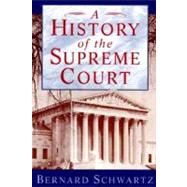A History of the Supreme Court
, by Schwartz, Bernard- ISBN: 9780195093872 | 0195093879
- Cover: Paperback
- Copyright: 2/23/1995
When the first Supreme Court convened in 1790, it was so ill-esteemed that its justices frequently resigned in favor of other pursuits. John Rutledge stepped down as Associate Justice to become a state judge in South Carolina; John Jay resigned as Chief Justice to run for Governor of New York;and Alexander Hamilton declined to replace Jay, pursuing a private law practice instead. As Bernard Schwartz shows in this landmark history, the Supreme Court has indeed travelled a long and interesting journey to its current preeminent place in American life. In A History of the Supreme Court, Schwartz provides the finest, most comprehensive one-volume narrative ever published of our highest court. With impeccable scholarship and a clear, engaging style, he tells the story of the justices and their jurisprudence--and the influence the Court has hadon American politics and society. With a keen ability to explain complex legal issues for the nonspecialist, he takes us through both the great and the undistinguished Courts of our nation's history. He provides insight into our foremost justices, such as John Marshall (who established judicialreview in Marbury v. Madison, an outstanding display of political calculation as well as fine jurisprudence), Roger Taney (whose legacy has been overshadowed by Dred Scott v. Sanford), Oliver Wendell Holmes, Louis Brandeis, Benjamin Cardozo, and others. He draws on evidence such as personal lettersand interviews to show how the court has worked, weaving narrative details into deft discussions of the developments in constitutional law. Schwartz also examines the operations of the court: until 1935, it met in a small room under the Senate--so cramped that the judges had to put on their robesin full view of the spectators. But when the new building was finally opened, one justice called it "almost bombastically pretentious," and another asked, "What are we supposed to do, ride in on nine elephants?" He includes fascinating asides, on the debate in the first Court, for instance, overthe use of English-style wigs and gowns (the decision: gowns, no wigs); and on the day Oliver Wendell Holmes announced his resignation--the same day that Earl Warren, as a California District Attorney, argued his first case before the Court. The author brings the story right up to the present day,offering balanced analyses of the pivotal Warren Court and the Rehnquist Court through 1992 (including, of course, the arrival of Clarence Thomas). In addition, he includes four special chapters on watershed cases: Dred Scott v. Sanford, Lochner v. New York, Brown v. Board of Education, and Roe v. Wade. Schwartz not only analyzes the impact of each of these epoch-making cases, he takes us behind the scenes, drawing on all availableevidence to show how the justices debated the cases and how they settled on their opinions. Bernard Schwartz is one of the most highly regarded scholars of the Supreme Court, author of dozens of books on the law, and winner of the American Bar Association's Silver Gavel Award. In this remarkable account, he provides the definitive one-volume account of our nation's highestcourt.







